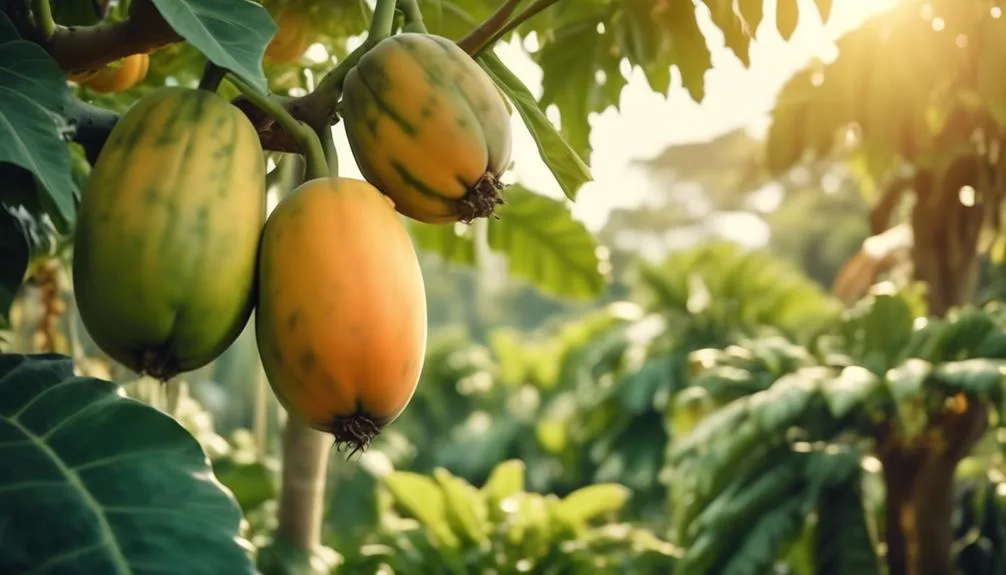When it comes to growing papaya trees for fruit production, choosing the right location is crucial. Factors like climate, sunlight, soil, and wind protection all play a role in the success of your harvest. Understanding these elements can help you make informed decisions about where to plant your papaya trees.
Let's explore the key considerations for maximizing the fruit-producing potential of these exotic trees.
Key Takeaways
- Papaya trees thrive in warm and humid climates with a temperature range of 70-90°F.
- Adequate sunlight, at least 6-8 hours of direct sunlight per day, is crucial for robust fruit production.
- Plant papaya trees in well-draining soil with a slightly acidic to neutral pH, such as sandy loam or loamy soil.
- Provide wind protection for young papaya trees through the use of windbreaks, staking, and proper tree placement.
Ideal Climate Conditions
In order to successfully grow papaya trees for fruit production, you need to ensure that they're planted in a warm and humid climate with plenty of sunlight. Papaya trees thrive in tropical and subtropical regions, where temperatures range between 70-90°F. Adequate sunlight is crucial for the trees to produce sweet and juicy fruits.
When it comes to watering frequency, papaya trees require regular watering, especially during dry periods. However, it's important to avoid waterlogging the soil as it can lead to root rot.
Additionally, selecting papaya varieties with disease resistance can help in preventing common papaya diseases such as papaya ringspot virus and powdery mildew.
Sunlight and Shade Requirements
Consider the optimal placement of your papaya trees to maximize sunlight exposure, ensuring they receive at least 6-8 hours of direct sunlight daily for robust fruit production. When selecting a planting location, prioritize an area with ample sunlight and protection from strong winds.
Proper tree placement and efficient canopy management are crucial to ensure that the papaya trees receive the required sunlight without excessive exposure, which can lead to sunburn and fruit damage. Adequate sunlight is essential for fruit ripening and sweetness, while also facilitating pollination techniques.
Soil Type and Quality
To ensure successful papaya tree growth and fruit production, it's essential to assess the soil type and quality of the chosen planting site. Papaya trees thrive in well-draining soil with a slightly acidic to neutral pH level. Sandy loam or loamy soil types are ideal for papaya cultivation as they provide good aeration and drainage, preventing waterlogging issues. Additionally, these soil types allow for optimal watering frequency and nutrient absorption, crucial for the healthy development of papaya trees.
When planting papayas, it's important to enrich the soil with organic matter to ensure proper nutrient availability. Furthermore, maintaining soil quality is vital for pest control and disease prevention. Healthy, well-balanced soil reduces the risk of pest infestations and helps papaya trees resist diseases, promoting a fruitful and thriving orchard.
Wind Protection
When selecting a site for planting papaya trees, ensure that you provide adequate wind protection to safeguard the young plants from potential damage and stress. Windbreak options such as planting tall shrubs or constructing fences can help mitigate the impact of strong winds on papaya trees.
Additionally, employing tree staking techniques can provide extra support to young papaya trees, preventing them from being swayed and damaged by strong gusts. Properly securing the trees to stakes can help them establish strong root systems and sturdy trunks, ensuring their resilience against windy conditions.
Spacing and Companion Planting
To optimize the growth and fruit production of your papaya trees, carefully consider the spacing and companion planting of other crops.
- Ideal Spacing: Ensure that papaya trees are planted at least 10 feet apart to allow for ample sunlight and airflow, which are crucial for healthy growth and fruit development.
- Companion Planting: Select companion plants such as legumes, basil, or marigold to promote a mutually beneficial environment. Legumes can help fix nitrogen in the soil, benefiting the papaya trees, while basil and marigold can repel pests that may otherwise affect the papaya trees.
- Root Competition: Be mindful of the root systems of other plants when companion planting. Avoid planting crops with aggressive or shallow root systems near papaya trees to prevent root competition, which can hinder the papaya tree's growth and fruit production.
Conclusion
In a sunny, sheltered spot with well-draining soil, your papaya trees will thrive and bear delicious fruit.
Consider companion planting to maximize growth and harvest.
With the right care, your backyard will soon yield a bountiful harvest of papayas.
Happy planting, and may your efforts bring forth an abundance of sweet and juicy rewards.

